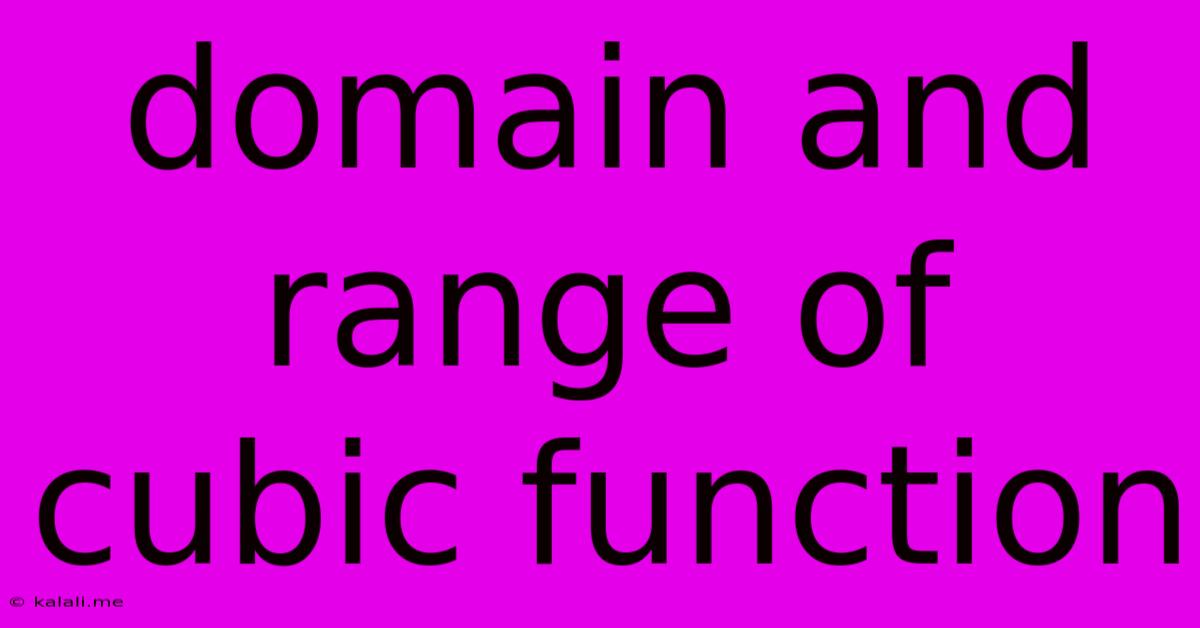Domain And Range Of Cubic Function
Kalali
Jun 12, 2025 · 3 min read

Table of Contents
Understanding the Domain and Range of a Cubic Function
The domain and range of a function are fundamental concepts in mathematics, crucial for understanding its behavior and graphical representation. This article will delve into the specifics of determining the domain and range of a cubic function, providing clear explanations and examples to solidify your understanding. Understanding these concepts is key to mastering more advanced mathematical topics and interpreting data graphically.
A cubic function is a polynomial function of degree three, generally expressed in the form f(x) = ax³ + bx² + cx + d, where a, b, c, and d are constants and 'a' is not equal to zero. Unlike some functions with restrictions, cubic functions exhibit a unique simplicity in their domain and range.
Defining Domain and Range
Before we dive into cubic functions specifically, let's quickly review the definitions:
-
Domain: The domain of a function is the set of all possible input values (x-values) for which the function is defined. Essentially, it's all the x-values that you can plug into the function and get a real number as an output.
-
Range: The range of a function is the set of all possible output values (y-values) that the function can produce. It's all the y-values you can obtain by plugging in values from the domain.
Domain of a Cubic Function
The beauty of cubic functions lies in their unrestricted domain. Unlike functions with square roots or denominators, which can have restrictions on their input values, cubic functions are defined for all real numbers. This means the domain of any cubic function is:
(-∞, ∞) or all real numbers
This is because you can substitute any real number for 'x' in the equation ax³ + bx² + cx + d and always obtain a real number as a result. There are no values of x that would lead to division by zero, taking the square root of a negative number, or any other undefined operation.
Range of a Cubic Function
The range of a cubic function is slightly more nuanced. While the domain is always all real numbers, the range depends on whether the cubic function has any horizontal asymptotes (which it doesn't). Unlike other polynomial functions like quadratics which may have minimum or maximum values limiting their range, a cubic function will always extend infinitely in both the positive and negative y-direction. Consequently, the range of a cubic function is also:
(-∞, ∞) or all real numbers
This is because as x approaches positive infinity, f(x) also approaches positive infinity, and as x approaches negative infinity, f(x) approaches negative infinity. There are no limits to the possible output values of a cubic function.
Examples
Let's illustrate this with a couple of examples:
Example 1: f(x) = x³ + 2x² - x + 1
This is a standard cubic function. Its domain is (-∞, ∞) and its range is (-∞, ∞).
Example 2: f(x) = -2x³ + 5x
This is another cubic function, even though it lacks the x² and constant terms. Its domain remains (-∞, ∞), and its range is also (-∞, ∞).
Conclusion
In summary, the domain and range of a cubic function f(x) = ax³ + bx² + cx + d (where a ≠ 0) are both all real numbers, represented as (-∞, ∞). This characteristic makes cubic functions relatively straightforward to analyze in terms of their input and output values. Understanding the domain and range is fundamental to graphing the function accurately and solving problems related to its behavior.
Latest Posts
Latest Posts
-
How Many Molecules In 1 Mole Of Water
Jun 13, 2025
-
What Is The Largest Ecosystem On Earth
Jun 13, 2025
-
Fire Safety Test Questions And Answers Pdf
Jun 13, 2025
-
Which Of The Following Has The Greatest Momentum
Jun 13, 2025
-
Are Metals On The Right Side Of The Periodic Table
Jun 13, 2025
Related Post
Thank you for visiting our website which covers about Domain And Range Of Cubic Function . We hope the information provided has been useful to you. Feel free to contact us if you have any questions or need further assistance. See you next time and don't miss to bookmark.